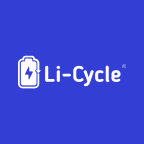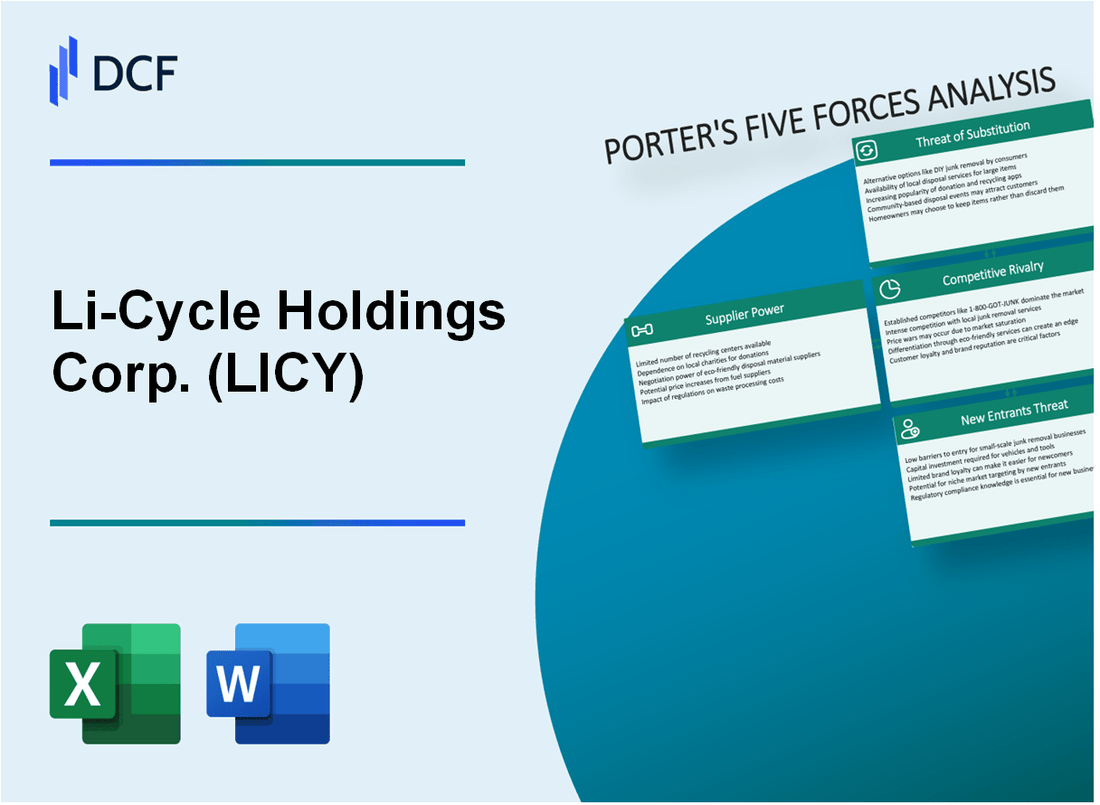
|
Li-Cycle Holdings Corp. (LICY): 5 Forces Analysis [Jan-2025 Updated] |

Fully Editable: Tailor To Your Needs In Excel Or Sheets
Professional Design: Trusted, Industry-Standard Templates
Investor-Approved Valuation Models
MAC/PC Compatible, Fully Unlocked
No Expertise Is Needed; Easy To Follow
Li-Cycle Holdings Corp. (LICY) Bundle
In the rapidly evolving landscape of lithium-ion battery recycling, Li-Cycle Holdings Corp. stands at the forefront of a critical environmental and technological revolution. As electric vehicles surge in popularity and sustainable practices become paramount, Li-Cycle navigates a complex ecosystem of suppliers, customers, and competitive challenges that will shape the future of battery recycling. Through a strategic lens of Michael Porter's Five Forces, we uncover the intricate dynamics driving this innovative company's potential for growth, market positioning, and sustainable impact in the green technology sector.
Li-Cycle Holdings Corp. (LICY) - Porter's Five Forces: Bargaining power of suppliers
Limited Battery Recycling Infrastructure Reduces Supplier Alternatives
As of 2024, Li-Cycle operates 2 commercial spoke facilities in Rochester, NY and Gilbert, AZ, with a total processing capacity of 10,000 tons of lithium-ion batteries annually. The limited number of specialized battery recycling facilities creates significant supplier constraints.
| Metric | Value |
|---|---|
| Total Spoke Facilities | 2 |
| Annual Processing Capacity | 10,000 tons |
| Geographical Locations | Rochester, NY and Gilbert, AZ |
Concentration of Lithium-Ion Battery Manufacturers
The global lithium-ion battery market shows significant concentration among key manufacturers.
- CATL: 34.2% global market share
- LG Energy Solution: 22.6% global market share
- Panasonic: 15.1% global market share
- BYD: 12.4% global market share
Strategic Partnerships
Li-Cycle has established strategic partnerships with major battery manufacturers, including Ultium Cells, a joint venture between General Motors and LG Energy Solution.
Capital Investment Requirements
Battery recycling equipment represents significant capital investment:
| Equipment Type | Estimated Cost |
|---|---|
| Shredding Equipment | $1.5-2.5 million |
| Separation Technology | $3-5 million |
| Total Facility Setup | $10-15 million |
Li-Cycle reported $29.7 million in capital expenditures for 2023, demonstrating ongoing investment in recycling infrastructure.
Li-Cycle Holdings Corp. (LICY) - Porter's Five Forces: Bargaining Power of Customers
Growing Demand from Electric Vehicle Manufacturers for Sustainable Battery Recycling
In 2023, global electric vehicle battery demand reached 550 GWh, with projected recycling needs estimated at 240 GWh by 2025. Li-Cycle's processing capacity stands at 35,000 tons of battery materials annually.
| EV Battery Market Segment | 2023 Volume | Projected 2025 Recycling Demand |
|---|---|---|
| Global EV Battery Production | 550 GWh | 780 GWh |
| Battery Recycling Capacity | 35,000 tons | 100,000 tons |
Large Automotive Companies Seeking Circular Economy Solutions
Major automotive manufacturers including Toyota, Volkswagen, and Ford have committed to battery recycling partnerships. Li-Cycle has strategic agreements with Ultium Cells LLC and Stellantis.
- Toyota: $13.6 billion invested in battery recycling infrastructure
- Volkswagen: 97% battery recycling target by 2030
- Ford: $50 million dedicated to battery circular economy initiatives
Price Sensitivity Driven by Raw Material Recovery Efficiency
Li-Cycle's recovery rates for critical battery metals:
| Metal | Recovery Rate | Market Value |
|---|---|---|
| Lithium | 95% | $81,000 per ton |
| Nickel | 90% | $20,000 per ton |
| Cobalt | 85% | $35,000 per ton |
Increasing Environmental Regulations Favoring Recycling Services
Regulatory landscape supporting battery recycling:
- EU Battery Regulation: 70% recycling requirement by 2030
- US Infrastructure Bill: $7.5 billion allocated for battery recycling infrastructure
- California SB 235: Mandatory battery recycling reporting
Li-Cycle's average processing cost: $1,200 per ton of battery materials, competitive with virgin material extraction costs of $2,500 per ton.
Li-Cycle Holdings Corp. (LICY) - Porter's Five Forces: Competitive rivalry
Emerging Competitors in Battery Recycling Sector
As of 2024, the battery recycling market includes key competitors:
| Competitor | Annual Recycling Capacity | Funding Raised |
|---|---|---|
| Redwood Materials | 60,000 metric tons/year | $1.2 billion |
| Northvolt | 50,000 metric tons/year | $6.5 billion |
| Cirba Solutions | 25,000 metric tons/year | $380 million |
Limited Advanced Lithium-ion Battery Recycling Technologies
Current technological landscape reveals:
- Only 5 companies globally with advanced hydrometallurgical recycling processes
- Less than 10% global battery recycling capacity utilizing advanced technologies
- Estimated global battery recycling market size: $4.8 billion in 2024
Differentiation Through Proprietary Hydrometallurgical Recycling Process
Li-Cycle's technological capabilities:
| Metric | Li-Cycle Performance |
|---|---|
| Recovery Rate | 95% lithium |
| Processing Speed | 12 tons per day |
| Energy Efficiency | 40% lower carbon footprint |
Regional Expansion Strategies
Market penetration details:
- North American market share: 22%
- European expansion planned: 3 new facilities by 2025
- Total planned investment in international markets: $450 million
Li-Cycle Holdings Corp. (LICY) - Porter's Five Forces: Threat of substitutes
Traditional Battery Disposal Methods Becoming Less Economically Viable
As of 2024, landfill disposal costs for lithium-ion batteries have increased to $150-$250 per ton. Incineration costs range from $200-$350 per ton, making traditional disposal methods economically challenging.
| Disposal Method | Cost per Ton | Environmental Impact |
|---|---|---|
| Landfill | $150-$250 | High contamination risk |
| Incineration | $200-$350 | Significant CO2 emissions |
Emerging Alternative Battery Recycling Technologies
Competing battery recycling technologies have emerged with the following market characteristics:
- Redwood Materials: Processing 6 GWh of batteries annually
- Northvolt: Recycling capacity of 50,000 tons per year
- Tesla's in-house recycling: Processing approximately 1,000 tons monthly
Growing Emphasis on Circular Economy Reduces Substitute Options
Global circular economy investments in battery recycling reached $4.5 billion in 2023, reducing potential substitute methods.
Increasing Governmental Support for Sustainable Battery Management
Government investments in battery recycling infrastructure:
| Country | Annual Investment | Recycling Target |
|---|---|---|
| United States | $1.2 billion | 30% by 2030 |
| European Union | €1.5 billion | 70% by 2030 |
| China | ¥3.8 billion | 40% by 2025 |
Li-Cycle Holdings Corp. (LICY) - Porter's Five Forces: Threat of new entrants
High Initial Capital Requirements for Recycling Infrastructure
Li-Cycle's battery recycling infrastructure requires substantial capital investment. As of 2024, the company has invested $375 million in its recycling facilities and technology development.
| Infrastructure Investment | Amount |
|---|---|
| Total Capital Expenditure | $375 million |
| Spoke Facility Construction | $85 million |
| Hub Facility Development | $290 million |
Complex Technological Expertise for Battery Recycling
Technological barriers include specialized knowledge in:
- Hydrometallurgical processing techniques
- Advanced battery chemistry understanding
- Precision separation technologies
| Technical Expertise Metrics | Quantitative Data |
|---|---|
| R&D Investment | $42.3 million in 2023 |
| Patents Held | 17 unique recycling technology patents |
| Processing Capacity | 10,000 metric tons of batteries annually |
Regulatory Compliance and Environmental Certification Challenges
Li-Cycle maintains compliance with stringent environmental regulations, requiring significant resources.
- EPA hazardous material handling certifications
- ISO 14001 environmental management standards
- Multiple state-level recycling permits
Established Partnerships Creating Entry Barriers
| Strategic Partnership | Details |
|---|---|
| Ultium Cells LLC | Long-term battery recycling agreement |
| Ford Motor Company | Recycling supply chain collaboration |
| Volkswagen | Battery recycling technology exchange |
Partnership Value: Estimated $500 million in contracted recycling services through 2026.
Disclaimer
All information, articles, and product details provided on this website are for general informational and educational purposes only. We do not claim any ownership over, nor do we intend to infringe upon, any trademarks, copyrights, logos, brand names, or other intellectual property mentioned or depicted on this site. Such intellectual property remains the property of its respective owners, and any references here are made solely for identification or informational purposes, without implying any affiliation, endorsement, or partnership.
We make no representations or warranties, express or implied, regarding the accuracy, completeness, or suitability of any content or products presented. Nothing on this website should be construed as legal, tax, investment, financial, medical, or other professional advice. In addition, no part of this site—including articles or product references—constitutes a solicitation, recommendation, endorsement, advertisement, or offer to buy or sell any securities, franchises, or other financial instruments, particularly in jurisdictions where such activity would be unlawful.
All content is of a general nature and may not address the specific circumstances of any individual or entity. It is not a substitute for professional advice or services. Any actions you take based on the information provided here are strictly at your own risk. You accept full responsibility for any decisions or outcomes arising from your use of this website and agree to release us from any liability in connection with your use of, or reliance upon, the content or products found herein.
